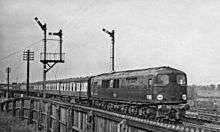British Rail Class D16/2
|
10201 at Tring, 1959 | |||||||||||||||||||||||||||||||||||||
| |||||||||||||||||||||||||||||||||||||
| |||||||||||||||||||||||||||||||||||||
| |||||||||||||||||||||||||||||||||||||
| |||||||||||||||||||||||||||||||||||||
British Railways Class D16/2 was a class of prototype diesel locomotive built by BR at Ashford Works and introduced in 1950–1951, with a third example being introduced in 1954. They had been designed by Oliver Bulleid for the Southern Railway before the 1948 nationalisation but did not appear until after nationalisation. The diesel engine and transmission were supplied by the English Electric company but the Bulleid influence was obvious. The box-like body style closely resembled Bulleid's electric locomotives and was quite different from the usual English Electric style, typified by British Rail Class D16/1.
Unusually for pioneer British diesels, 10201 and 10202 were originally specified (prior to alteration of gear ratios to improve tractive effort when operating as mixed-traffic units) with a top speed of 110 mph (180 km/h) rather than the 90 mph (140 km/h) of 10203,[1] pre-dating the three-figure maximum speeds of the Deltic and Class 50 designs by some years.
Percie Bollen's bogie design and the power train of 10203 were taken almost unmodified for the first ten production D16/1 but with a more traditional English Electric design of body with prominent noses and louvered side panels.
Operation

The original locomotives, numbered 10201 and 10202, worked services on the Southern Region of British Railways. They were transferred to Camden depot in the London Midland Region in April 1955.
Number 10203 was outshopped from Brighton works in March 1954, its modified engine giving a power output of 2,000 hp (1,500 kW). It was trialled on the Southern Region before joining its sisters on the London Midland, being allocated to Willesden depot.
All three locomotives were non-standard with regards to spare parts and servicing and they were withdrawn at the end of 1963. After spending some time on the scrap line at Derby Works they were eventually scrapped at Cashmore's at Great Bridge in 1968.
Additional information
- Bogie wheelbase (rigid): 16 ft 0 in (4.88 m)
- Bogie wheelbase (total): 21 ft 6 in (6.55 m)
- Bogie pivot centres: 28 ft 6 in (8.69 m)
- Sanding equipment: Pneumatic
- Heating boiler: Spanner
- Gear ratio: Originally 17:65, amended to 19:61
- Boiler water capacity: 880 imp gal (4,000 l; 1,060 US gal)
- Boiler fuel capacity: From main supply
References
- Strickland, David C. (September 1983). Locomotive Directory. Camberley, Surrey: Diesel and Electric Group. pp. 27, 29. ISBN 0-906375-10-X.
- Stephens, Robert (1988). Diesel Pioneers. Atlantic Transport. ISBN 0-906899-29-X.
Further reading
- Clough, David N. (2011). "2: Diesel-Electric Development after 1945". Hydraulic vs Electric: The battle for the BR diesel fleet. Ian Allan. pp. 19–24. ISBN 978-0-7110-3550-8.
- Nock, O.S., "Performance and Efficiency Tests on S.R. Diesel Electric Locomotive", The Engineer, 196 No.I, 2 Oct. 1953, pp.424-427, No.II, 9 Oct. 1953, pp.451-453
- Nock, O.S., "Performance of 2000 H.P. Main-Line Diesel-Electric Locomotive", The Engineer, 201 No.I, 25 May 1956, pp.550-553, No.II, 1 June 1956, pp.588-591
External links
| Wikimedia Commons has media related to British Rail Class D16/2. |
- Muspratt, Graham, "Bulleid 1CoCo1 Diesel Electric Locomotive", www.semgonline.com
- "10201-10203", The Railway Centre
- Photo of 10201 in Birmingham New Street
